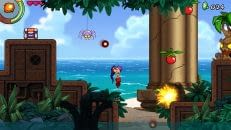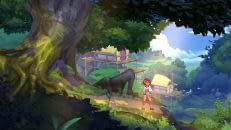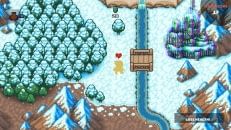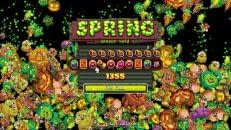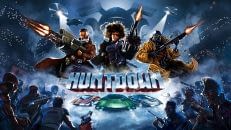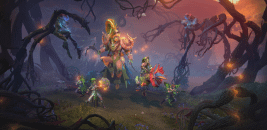Riding Out The Storm: An Interview With Rob Storm About Project Stormos
Vital to the success of a platformer is how it ‘feels’. This is how much of an affinity the player has with the controls. If a developer can get this right, then they often find that everything else falls into place. Project Stormos is one of those platformers that feels right. Superboss Games’ hardcore platformer has you practically flying a robot around its non-linear levels. It’s a platformer that works best when you do not touch any platforms at all. The game also comes with a fantastic level editor so that the community can generate their own content and share their ideas. The game has more or less come out of nowhere and despite having only a short lifespan and not even being released yet, the reception thus far has been far greater than the developers could have anticipated.
Currently, Project Stormos is seeking more funding via Kickstarter so that more levels can be added, and work on a console port can be started. We managed to grab some time with Stormos’ eager developer, Rob Storm, and question him about our new fascination.
IGM: What is your story? How did you get into making games?
Rob Storm: When I was a little kid, I liked to copy what my older brother did cause I was trying to be cool and find out what’s fun and interesting. It was around third grade when we were playing Mortal Kombat 2, that my brother and his friend were drawing up character designs for an MK-like game. So I started doing the same thing.
Later my friend Allen showed me games like Final Fantasy 6 and that’s when I knew I really, really wanted to design games. Then I got a Playstation one and games like Resident Evil, Final Fantasy VII, Metal Gear. Those had a huge influence on me early on.
Started trying to 3D model when I was 9 and then eventually programming in middle school and the beginning of highschool; RPG maker, half-life modding, unreal modding. Went on to different platforms from there and eventually University for game development.
IGM: So, you had your mind set on making games from an early age. At university you must have had a chance to meet a lot of like minded people, were you then encouraged to go into indie development as opposed to trying for a job in a studio?
RS: Originally (and somewhere inside of me still) I had some pretty grandiose ideas that would take a huge team to accomplish effectively. University was good because it had me actually finishing projects on a reasonable scale with groups instead of just myself.
I managed to meet some great people like Austin Roush, who I am currently working on some other secret projects with. Great stuff. Now I like working on games in small groups because you have a ton of freedom with the game design and that is the most important.
IGM: Totally agree. How do you go about thinking up game ideas? What kinds of processes do you go through, how do you decide what sticks and what you let slide?
RS: I have two main steps for developing good gameplay. The first is imagining a scene from a movie or book, something exciting just when you tell somebody about it. And then trying to backwards engineer that scene into a set of controls. So take an action sequence and then say, how could I map this to a keyboard that give the players the most control over the details.
The other step is not to try to force gameplay situations so much. Usually I develop ideas as I’m writing code and trying stuff out. It’s very organic, you start playing your game and it grows as you try something and go, “Whoa that’s cool!”. A lot of times it’s accidental, but if you play your game while thinking of ideas all these fresh concepts start popping up. It just keeps building from there!
IGM: I think ‘organic’ pretty much hits the nail on the head there. So let’s move on to your main project at the moment – Project Stormos. Now, Stormos has been in development for a while now, did you envision this as such a long term investment from the start?
RS: The game began as a project I designed freshman year of university for a game development class. The first version was in Game Maker actually. I think it’s still floating around the internet somewhere.
I made other games throughout school in the mean time but kept coming back to playing that game. So after graduating, I got together with some friends from the game development major and started making a 3D version in XNA. That was going really well, but for various reasons like team members (including myself) dealing with jobs, moving, life changes etc; it kind of came to a halt.
Then after working in NYC for a year developing in Unity, I decided to take another stab at it myself and was blown away at how fast I could develop it. Really! This version was made from scratch from the ground up starting in May.
IGM: After having played it myself, I can safely say that is very impressive!
RS: Thanks! I hope it hasn’t been too punishing. Any ‘no platforms’ completions?
IGM: Well, I often refer to myself as a gaming masochist, so the more punishing the better! And yes, I managed a few ‘no platforms’ completions on my first runthrough and then managed a whole load more when I replayed levels. So for those who haven’t had the privilege, how would you describe Project Stormos?
RS: I would describe it as a hardcore platformer, with insane aerial stunts, combat, and non-linear level design. It is difficult but always fair. Once you get to the “click point” it’s like Zen, you fly through the air effortlessly in spite of crazy arrays of obstacles.
Take Devil May Cry 3, combine it with Symphony of the Night and add a little bit of Megaman.
IGM: Indeed. I found that the controls felt odd at first, but once you grow accustom to them, the game really lets you in and it becomes an absolute joy to play. There is a sense of speed and peril at almost every moment, and it feels very natural to me as a player. Perhaps the biggest surprise in the game is its level editor, was this included from the start? As far as I am aware, you used it to create the levels in the game.
RS: The XNA version of the game had a level editor, so the idea was included from the start of the Unity development. About 95 percent of the levels were made in the level editor at the moment. So it’s a very powerful tool.
I wanted to make sure people had access to it and their creations were easy to pass around. It’s actually quicker to make levels in the level editor that in Unity itself.

IGM: Yeah, community features are a popular hit with mostly any game. Do you plan on catering for a community around the game, and future projects of yours? How important is it to you, to interact with fans and allow a degree of player freedom? Is this part of your game design philosophy?
RS: Having a community that’s talking about the game and sharing content is really important to me. It really extends the players connectedness to the game. I’ll always think back to people making maps and mods for the original Half Life and how almost a world outside of the game is created on top of it.
Sharing levels, replays, design ideas etc. That stuff is awesome. I love with other games when I see people showing off their technique with replays on Youtube. I want people to be competing with each other to push the game to it’s limits.
Level editing contests will definitely be coming soon as well!
IGM: That’s excellent news! I think the non-linear design of the levels really encourages the player to experiment with speedruns as well. Combined with the online leaderboards, I found myself striving to outdo the others by trying out different routes for smoother runs. Although, trying to beat a developer at his own game is proving to be a challenge.
RS: Yeah, a lot of times when I’m designing the levels, I don’t even know what the best route will be. Because there’s not a lot of physical walls per se (since you’re floating in the air), you often end up connecting routes that I didn’t know was possible. My friend Steffen and I were playing this one level over and over again and were competing for times around 20 seconds. One time I got like a 20.453 sec on that level and I told him he’d never beat it. He came back the next day with a 13.483 (or around there) because he found a route neither of us had thought of before.
IGM: I love that! Despite Stormos having the capability to grow a community, the most important aspect is marketing the game. How have you found the best way to do that so far?
RS: I think the most important aspect of marketing the game is getting it to the right people. By that I mean well known websites or reviewers but also hardcore gamers who really have an eye for good game design.
This is a gamers game as I’ve said, because it allows creativity, is precise, and doesn’t hold your hand all the time. I know that the right people will help make it spread.
IGM: You have seen some attention with your recent Kickstarter campaign, why did you start the campaign and what is the plan if you receive the money you have asked for?
RS: My plan with the money is for allowing more development time as well as Unity licenses for PS3 and Xbox. The game also plays really well with a controller and I think people will really take to it there. The money will also go towards a commercial that someone I know is working on, other marketing stuff, as well as stuff like server costs. And as stated before, some will go towards allowing time for development of tons of new levels and obstacles, story sequences etc.
I want to continue developing this game even after release so there’s always new content for people to work with. The Kickstarter campaign helps with creating awareness and smoothing that time out.
IGM: It all sounds very promising! Do you have any rough deadlines for the game at all?
RS: Very, very shortly after the Kickstarter campaign has finished, I’ll be putting the game up on ProjectStormos.com and people will be able to continue to play it and get new updates from there for free after they’ve bought the original version.
The surest way to start playing the game immediately is through the Kickstarter. But it is a Minecraft model of giving people accounts with free updates up through the final release when everything is “complete.” But I wanted to make sure the game was extremely playable and had plenty of content even up to that point. You’ll still get hours of play out of the demo I’ve been handing out at the Kickstarter.
IGM: During the development process of Project Stormos, what have been the most important lessons that you have learned? What advice would you pass on to fellow indie developers?
RS: I would say to always remember to dissect and analyze the games you’re playing. Be objective and see what truly is making the great ones great.
Also, that if you have an idea start making it and experiment that entire way. Don’t try to make something that you hope everyone else will like. Make something that you feel is the game you’ve always wanted to play and don’t compromise on that. There’s going to be a lot of people that have those same wishes as you, so take risks and make something even if it flies in the face of what’s popular in game design now.
IGM: That’s the kind of ‘against the grain’ advice I like to hear! Unfortunately, all good things come to an end. So thank you very much for participating, I love your game and feel everyone should know about it. So where can people find out more information?
RS: Thank you, it has been a pleasure! The best place to find information is at the Kickstarter page, the homepage at http://projectstormos.com/ and the IndieDB page.

